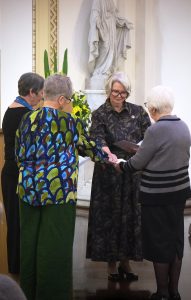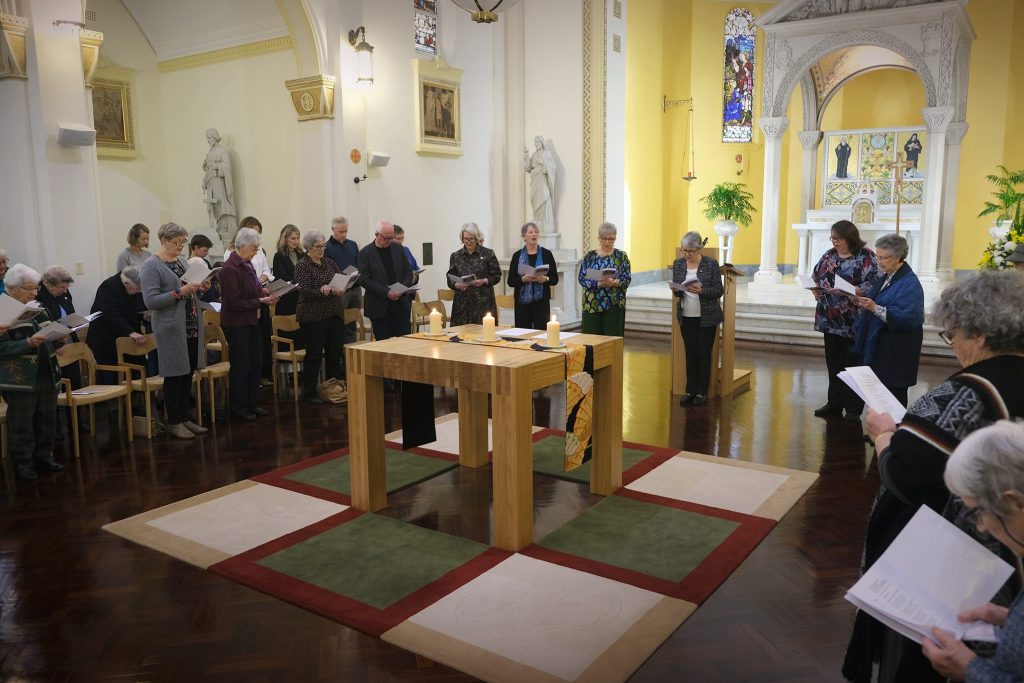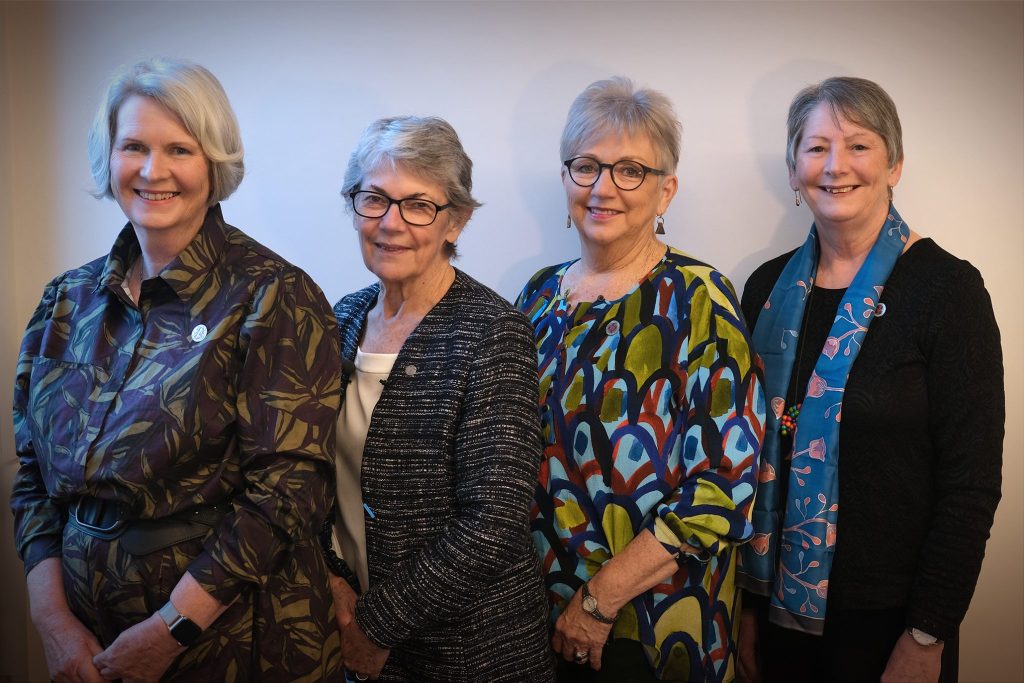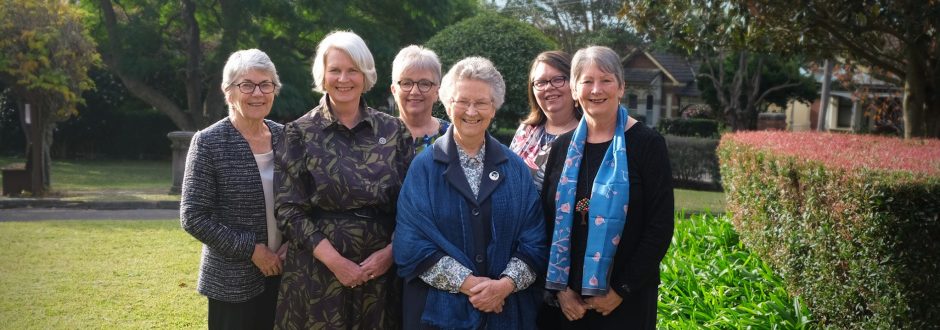A new era of lay governance has begun for Good Samaritan Oblates, with the recent commissioning of the inaugural Oblate Leadership Team and Oblate Council.
Oblates Marie Milne, Marie Mohr and Pat O’Gorman were commissioned to be the first lay leadership team for the Good Samaritan Oblates. The Oblate Council members are Oblates Loretta Brinkman, Donna Cooper, Susan Delfin, Pat Hearity and Kathy Moran, along with Sister Christine Manning SGS.
The commissioning was the culmination of a years-long prayer and discernment process aimed at bringing to life a call from the Sisters of the Good Samaritan Congregational Council for the Oblates to be lay led.
Sister Sonia Wagner SGS, the outgoing Oblate Coordinator, said the commissioning of the Oblate Leadership Team was a significant moment for both the Congregation and the Oblates.
“It has been an evolution over many years,” she said. “And there has been a whole host of people involved in arriving at this point.
“For me, it’s the completion of a task given to me by Congregational Leader Sister Patty Fawkner SGS in 2018. The mandate was for the Oblate Committee, which I chaired, to prepare the ground for Oblate leadership and governance.
“In subsequent years, we’ve done a lot of work together on developing a framework for governance and arriving at the model of leadership we now have.
“I’m feeling delighted about it. And, of course, it’s not as though I and the Sisters are going to disappear off the scene. I see myself as a mentor and companion to our Oblates, but the new structure is much more collegial – after all, we are growing a community, not setting up an organisation.”

Commissioning of the Oblate Leadership Team: Marie Mohr, Pat O’Gorman and Marie Milne, with Oblate Coordinator Sr Sonia Wagner SGS. Image: Lissa Brown/Sisters of the Good Samaritan.
Congregational Council delegate for Oblates, Sister Veronica McCluskie SGS, said it had become clear early in the process how important it was to do the groundwork and lay firm foundations for the Council’s vision for Oblate lay leadership.
“We were tasked with looking at how the Oblate group could take over and be responsible for their own leadership and governance. Not that they would become separate but, rather, interdependent,” she said.
“The Sisters would still be there to support them and encourage them, but the actual leading now has been passed into the hands of these three women.”
Veronica said the Council’s vision for lay leadership of Oblates, while acknowledging the declining number of active Sisters available for such a role, was more fundamentally about recognition of the Oblates’ own vocation.
“The Council believed it was time to allow them to take over and have their rightful place in lay leadership, which fits with our broader vision for a synodal Church,” she said.
Member of the Oblate Leadership Council, Pat O’Gorman, said the commissioning in St Scholastica’s Chapel in Glebe on June 3 was a “beautiful occasion”.
“It was a very meaningful, encouraging, and important acknowledgement for the whole community about the new steps we are taking,” she said.
Sisters look to the future
Pat said the roots of the move towards lay leadership of Oblates could be traced as far back as the 21st Chapter of the Sisters of the Good Samaritan in 1987 when the Sisters began speaking about new ways of belonging as they looked to the future and what might be needed.
The first Oblate group began in 2001 and today there are 84 Oblates in 11 groups across Australia and the Philippines. Over the years, 28 Sisters have been involved in leading and accompanying Oblate groups.
While the question of lay leadership for the Oblates first arose in 2018-19, Pat said it was not an outcome that could be achieved quickly.
“Things take time and it’s important to take the time that’s necessary to discern and work out what’s needed,” she said.
A Visioning Group was formed to look at how to strengthen the identity of the Oblate groups and make the leadership of the Oblates sustainable into the future.
“We talked a lot about how we could be in relationship with the Sisters but distinct from them,” Pat said.

The blessing of the Oblate Leadership Team with Oblate Council members. Image: Lissa Brown/Sisters of the Good Samaritan. Image: Lissa Brown/Sisters of the Good Samaritan.
After much discussion, discernment, and consultation across the whole community of Oblates and Sisters, a Governance and Leadership Framework, proposing a Leadership Team of three, supported by a Council, was launched by Patty in February this year.
“A number of us in the Visioning Group had worked across Catholic and other organisations, and saw leadership as distributive, rather than something to be held in one person’s hands,” Pat said.
“We also saw this leadership model as a way of harnessing the various gifts across the Oblate community. It became very obvious that however the leadership took place it needed to be done in a collaborative way that built the community.”
Supporting and empowering Oblates
Pat said it was typical of the Sisters that they would be keen to both support and empower their Oblates in this way.
“It’s a claiming of everyone’s baptismal gifts,” she said. “God’s calling all of us in some way and we can all respond to that. We see it as modelling a type of Church that we would like to be part of.
“It’s also very Benedictine and the way we bring it to life will be Benedictine, communicating and consulting with the Sisters. There is that sense of mutuality that you find in the Rule of Benedict.
“It will challenge our Oblate communities to step up into this new role, not so dependent on the Sisters as perhaps we have been in the past but strengthening our own identity within the Good Samaritan-Benedictine charism and building a communion of communities.”

Sr Patty Fawkner SGS, second from left, with the Oblate Leadership Team, from left: Marie Milne, Marie Mohr, and Pat O’Gorman. Image: Lissa Brown/Sisters of the Good Samaritan.
Marie Milne said the call from Patty at the 2018 Pilgrims, Pathways and Possibilities Conference to embrace the term ‘Good Samaritans All’ was an energising moment for the Oblate community.
“It’s an expansive view of how we share our Good Samaritan charism,” she said. “It’s not something to box up or contain but, rather, it’s about walking together into the future.”
Marie said another key marker in the journey towards the new Oblate Leadership model was her visit with Sonia to the Cottonwood Benedictine Community in the US in 2019 for a symposium where other Benedictine Oblate groups spoke about their own moves towards developing Oblate leadership.
“While there we saw possibilities for a way forward. Since then, we have moved ahead steadily, focused always on developing a leadership and governance model that promoted self-sufficiency and built sustainability while retaining an ongoing and interdependent relationship with the Sisters,” Marie said.
“The Congregation was extremely supportive during this process, generously investing what was necessary for this to come to fruition.”
Oblate Leadership Team
Marie said the three members of the Leadership Team would work together, while also having specific areas of focus. Marie’s role as Group Support Coordinator, focuses on supporting, mentoring and encouraging the local Oblate groups and their coordinators. Marie Mohr is Communications and Administration Coordinator, while Pat is the Formation Coordinator.
“I see my role as being about listening deeply and responding to the hopes and challenges of the Oblate groups, appreciating their distinctiveness, and supporting them to move confidently into an unfolding future,” Marie Milne said. “As our Oblates are geographically distanced, it will also be about discovering creative ways to build community by fostering tangible connections among the groups. Now, perhaps more than ever, there is a renewed need for us to interpret what it means to be a Good Samaritan Benedictine Oblate in the context of our daily lives.”
Marie said she was delighted to be working as part of the new leadership model.
“We’ve already developed a really collaborative way of working together. As each of us lead full lives, sharing the leadership helps greatly in making it achievable.”
For Marie Mohr, the inauguration of the Oblate Leadership Team was a sign of the Oblates growing in confidence as the Sisters called them forward and supported them to take on their own leadership.
“When the Council first called for lay-led Oblates there weren’t any takers, and it was clear that we weren’t quite at that point at that stage,” she said.
“Over the past five years there has been a progressive uptake from lay people getting more confident in their capacity to take this lay movement further.
“It is a privilege, really, that the Congregation was bringing the Oblates, partners and associates to the table to share in the future direction.
“We are now at the very beginning of what the future will hold for the Oblate community. It’s exciting. A lot of work has been done by a lot of people to get here and the process itself has been such a gift, a real time of Spirit-led, prayerful discernment and growth.
“Our job as the Leadership Team will be to listen and support the Oblates on the ground in living out our Good Samaritan-Benedictine charism, modelled so beautifully by the Sisters, but brought to life in our own day-to-day lay context.”
If you would like to know more about Good Samaritan Oblates or find out more about connecting, click here.
